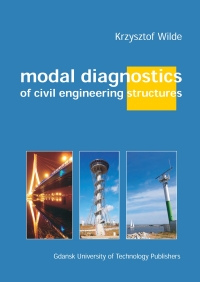
Modal diagnostics of civil engineering structures
ISBN: 978-83-7348-227-2
Numer wydania: 1
Rok wydania: 2008
Język wydania: angielski
Liczba stron: 196
Opis:
Książkę można pobrać bezpłatnie ze strony Pomorskiej Biblioteki Cyfrowej.
Profil naukowy Autora (MOST Wiedzy) – Krzysztof Wilde
Słowa kluczowe: analiza modalna, diagnostyka, dynamika budowli
In this book a use of three types of damage detection methods on the experimental modal parameters are studied. To the best of the author’s knowledge, there are relatively few publications that refer to the efficiency of damage location on data obtained from the in situ measurements.
The first type damage detection methods presented in this book are techniques based on the wavelet analysis. The wavelet analysis, under consideration, do not need any theoretical models of the structure nor information on undamaged structure. Only the experimental mode shapes of structure in the current state are needed. This method belongs to a group of methods that search the crack location from the derivatives of the mode shapes. The wavelets act as a differentiating operator, and therefore, have all the constrains of this type of methods. The method is effective in detecting only relatively large cracks.
The second direction in modal diagnostics, followed in this book, is Finite Element model updating. In this case the mathematical model of the structure dynamics is necessary. It is also necessary to conduct the measurements of the damaged and undamaged structure. Only the updating that uses the reference data can give the correct and practically useful information. There are many papers on updating based on natural frequencies. In this book the updating using both frequencies and experimental mode shapes is discussed. The effective iterative algorithm is searched.
The third type of the modal diagnostics is the proposition of a combination of an artificial neural network with diagnostic data obtained from simple ambient tests and detailed forced vibration tests. In both cases the experimental frequencies and these mode shapes are used as the network input. The proposed strategy assumes a multilevel approach in the sense that cheap ambient tests, that can be easily performed on an existing structure, are conducted to detect the presence of the damage. In doubtful cases about the integrity of the structure, some forced dynamic testes are suggested. Both levels of the structure diagnostics are facilitated by a neural network. This part of the book is rather a presentation of a concept than a systematic study on the neural expert system.
Pobierz spis treści (pdf, 188.35 KB)
Zakup publikacji:
| format | cena netto | cena brutto | dostępność |
|---|---|---|---|
| e-book | 0,00 | 0,00 | dostępne |

